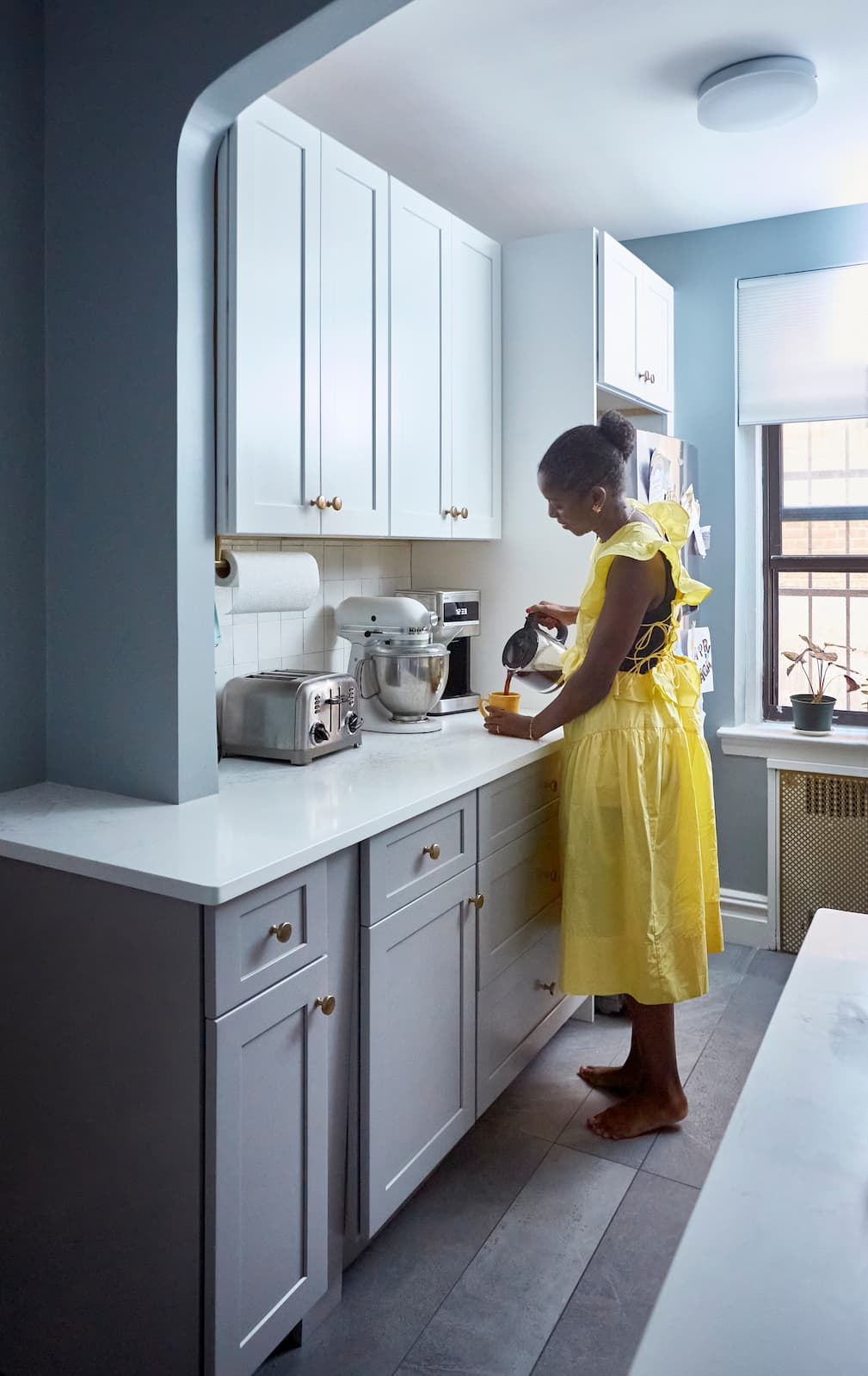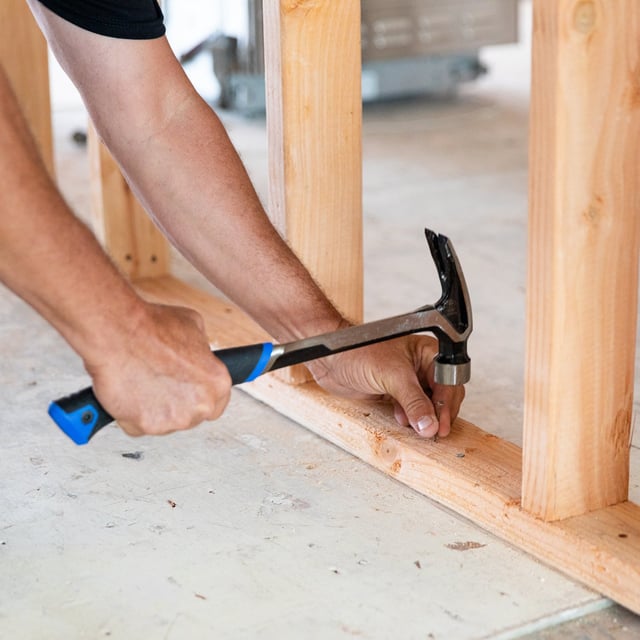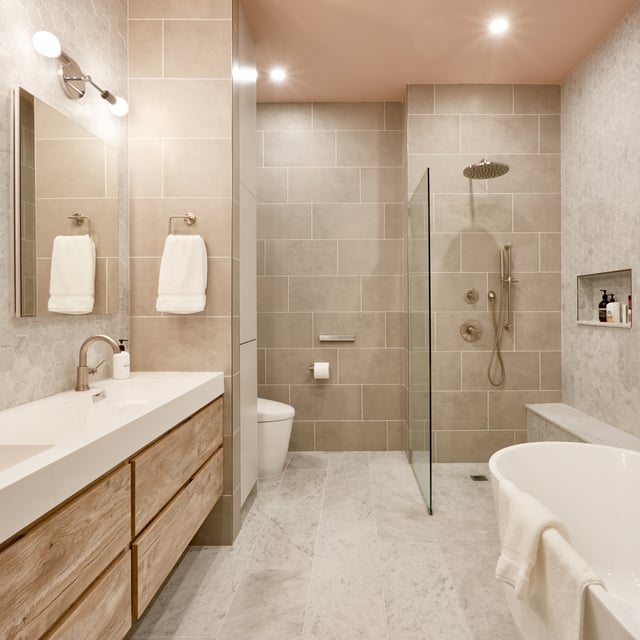
Cost
How Much Does a Bathroom Addition Cost?
09.26.2025

In This Article
Remodeling a living space is an exciting opportunity to create a room that feels new, comfortable, and functional. Whether it's a place for family gatherings, a cozy corner for reading, or even a spot for working from home, a living room serves many purposes.
On average, the cost of remodeling your living room falls between $2,500 and $15,000.
However, this can vary depending on the extent of your project and the materials you choose. With these numbers in mind, diving into a remodel can seem overwhelming, but with thorough planning, your dream living space is well within reach!
Let's explore what influences these costs and how you can navigate them.
When considering a remodel for your living space, it's helpful to understand the typical cost range. On average, homeowners spend between $2,500 and $15,000 on a living room remodel. This range can cover everything from a simple update, like painting walls and refinishing floors, to more extensive renovations that might include new flooring, lights, and built-in storage. It's important to consider your budget and plans carefully to ensure you get the most out of your remodel without overspending.
The size of your living room plays a significant role in determining the cost. For example, remodeling a 250-square-foot room generally costs between $2,500 and $15,000, though this can fluctuate based on the specific updates you decide to make. Larger spaces might cost more due to the increased materials and labor required. Additionally, the average remodel cost per square foot can range from $10 to $60, depending on the updates' complexity and materials used.
Regional differences can also influence remodeling costs. For example, prices might be higher in large urban areas compared to smaller towns. When planning your remodel, consider obtaining estimates from multiple contractors to get an accurate picture of what your project might cost in your region. This will help you budget effectively and make informed decisions about your living space remodel.
Generally speaking, here’s a quick summary of the costs based on room size to give you a clearer picture:
|
Living Room Size
|
Average Remodel Cost (Urban)
|
Average Remodel Cost (Suburban)
|
|
200 sq. ft.
|
$3,000–$12,000
|
$2,000–$9,000
|
|
250 sq. ft.
|
$3,500–$15,000
|
$2,500–$11,000
|
|
300 sq. ft.
|
$4,000–$18,000
|
$3,000–$13,500
|
|
350 sq. ft.
|
$4,500–$21,000
|
$3,500–$15,750
|
|
400 sq. ft.
|
$5,000–$24,000
|
$4,000–$18,000
|
When planning a living space remodel, several key factors can significantly influence the overall cost. The size and scope of the project are major determinants, as larger or more complex renovations typically require more materials and labor.
Choices in materials and finishes can also impact expenses, with high-end selections costing more than standard options. Additionally, where you live plays a role in costs, as regional price differences can affect both materials and labor charges. Understanding these factors can help you make informed decisions and keep your project within budget.
The size of your living space greatly affects the cost of remodeling. Larger rooms naturally require more materials and labor, leading to higher expenses. For instance, a 250 sq.ft. living room remodel might range from $2,500 to $15,000, whereas a remodel of a 400 sq.ft. space could cost between $4,000 and $24,000. The specific features you choose to include, such as new flooring or wall installations, can further influence the cost within these ranges.
The project's scope is also crucial in determining overall costs. A full-scale renovation involving structural changes, like removing walls or adding built-in features, will be more expensive than simple updates, such as painting or adding new furniture. Complex projects often require specialized professionals, which can increase labor costs. Therefore, clearly defining your renovation goals can help set realistic expectations and manage expenses effectively.
Material choices offer a wide range of options, each affecting the overall cost of a living space remodel. Opting for high-quality materials typically means a higher initial investment, but they often provide better durability and aesthetic appeal. For example, hardwood flooring costs more upfront than laminate, yet it can boost the home's value and outlast cheaper materials.
Here’s a more detailed view of how various material choices can affect your budget:
Wall Coverings:
Storage Solutions:
Labor costs are a critical component of a living space remodel, typically accounting for 40% to 50% of the total expenses. For a standard 250 sq.ft. living room, the cost of labor can range from $3,200 to $4,000, depending on the complexity of tasks involved. Various professionals like electricians, carpenters, and painters may be required, each contributing to the overall labor expenses.
Below are some average labor costs for different professionals involved in a remodel:
These figures help illustrate how labor can significantly impact your remodeling budget, emphasizing the importance of obtaining multiple quotes to ensure cost-effective choices.
The location of your home plays a significant role in determining the cost of remodeling a living space. In large urban areas or cities with a high cost of living, such as New York City or Los Angeles, you may find higher prices for both materials and labor. This is often due to increased demand for skilled labor and higher operating costs for contractors in these areas.
Conversely, in smaller towns or rural regions, the cost of living is generally lower, which can translate to reduced expenses for a remodel. Here, you might benefit from more competitive pricing among contractors and suppliers. However, it's important to note that some specialized materials or high-end finishes may still carry a premium regardless of location.
Understanding the cost breakdown of a living space remodel helps in planning and budgeting effectively. Remodeling expenses can be divided into key categories such as flooring, painting, furniture, and additional features like storage or lighting. By examining each category, homeowners can allocate funds wisely and make informed decisions to reach their renovation goals.
Flooring is a vital component of any living room remodel, significantly impacting the room's appearance and overall feel. The cost of flooring can vary widely based on the material chosen. For instance, vinyl flooring is an affordable option, with costs ranging from $500 to $3,500, providing durability and ease of maintenance. On the other hand, selecting hardwood flooring not only offers a classic and high-quality finish but can cost between $1,500 and $3,000, a more significant investment that enhances the home's value.
For those who prefer a more luxurious touch, materials like marble tiles are an option, with prices ranging from $3,000 to $14,750. While this choice demands a higher budget, it brings an exquisite, elegant style to the space. If sustainability is a priority, bamboo flooring might be suitable, costing between $2,500 and $6,250. Bamboo is not only eco-friendly but also offers impressive durability, making it a smart choice for environmentally conscious homeowners.
Painting is one of the most cost-effective ways to refresh a living space, allowing homeowners to introduce new colors and vibes without extensive renovations. The cost to paint living room walls typically ranges from $2 to $6 per square foot, depending on factors like the quality of paint and the complexity of the job, such as painting over a darker color or adding special finishes. A fresh coat of paint can instantly brighten the space, making it feel fresh and inviting.
For those looking to make a bold statement, accent walls or custom designs can create a focal point and add character to the room. These options might increase costs slightly, especially if they involve multiple colors or textures. However, even with these special touches, painting remains a relatively affordable enhancement compared to other remodeling activities, effectively transforming the space with minimal investment.
Updating furniture is a key aspect of remodeling a living space, as it not only enhances functionality but also contributes significantly to the room's overall aesthetic. The cost of furniture can vary greatly depending on the type and quality of pieces chosen. For instance, a new couch can range from $500 up to $5,000, offering options from budget-friendly to luxury models. Armchairs or recliners might cost between $200 to $3,000, providing additional comfort and style.
Many homeowners choose to mix new furniture with existing pieces to manage costs effectively. For example, reupholstering an old couch can cost between $750 and $3,500, which often proves more economical than buying new, while also allowing for customization that fits the new design scheme. By thoughtfully selecting furniture pieces and considering options like reupholstering, you can achieve a cohesive, updated look that aligns with both your style preferences and budget constraints.
A budget remodel focuses on making impactful changes without overspending, ideal for homeowners looking to refresh their living space affordably. By prioritizing essential updates and selecting cost-effective materials, you can achieve a stylish transformation. For instance, opting for vinyl flooring, which ranges from $500 to $3,500, provides durability at a lower cost. Similarly, repainting the walls with a fresh color can range from $2 to $6 per square foot, offering a quick lift to the space.
Furniture updates in a budget remodel often involve smart strategies like reupholstering existing pieces or purchasing versatile items such as an affordable couch within the $500 to $1,000 range. Mixing and matching new and old furniture helps create a cohesive look while keeping expenses down. With savvy choices and a clear vision, you can revitalize your living room while adhering to a sensible budget.
A mid-range remodel strikes a balance between quality and cost, allowing homeowners to make substantial improvements without reaching for luxury price tags. This approach often includes upgrades with materials that offer durability and style, such as hardwood flooring, which can cost between $1,500 and $3,000. Such investments enhance both the functionality and aesthetic appeal of your living space.
In terms of furnishing, a mid-range remodel might incorporate a mix of new furniture pieces and stylish reupholstery. For instance, selecting a new couch and a couple of armchairs could range from $1,500 to $3,500, offering both comfort and modernism. Additionally, incorporating custom lighting fixtures or upgrading window treatments can further polish the room's look. By carefully selecting mid-tier options, homeowners achieve a polished, refreshed living space that balances elegance and budgetary considerations.
A high-end remodel transforms a living space into a luxurious and sophisticated environment, using top-of-the-line materials and custom features. This type of renovation typically involves premium choices such as marble flooring, which can range from $3,000 to $14,750, offering a sleek and elegant finish that becomes a statement piece in the room. High-quality custom wood paneling or intricate wall treatments may also be included to add depth and richness to the space.
When it comes to furnishings, a high-end remodel often includes designer pieces that can significantly elevate a room's appearance. For example, investing in a custom-built entertainment center or high-end furniture sets can easily reach or exceed the $5,000 mark, but these pieces offer both beauty and functionality. Additionally, incorporating elaborate lighting fixtures, like chandeliers, and luxurious fabrics for window treatments can further emphasize the upscale transformation. By choosing premium materials and bespoke designs, homeowners can create a lavish living space that reflects personal taste and luxurious comfort.
Remodeling a living space doesn't have to break the bank if you employ some smart cost-saving strategies. By carefully planning your budget and making thoughtful choices, you can achieve a stylish and functional transformation without overspending. Here are a few practical tips to help you save money while still enhancing your living space effectively.
When sourcing materials for a remodel, looking for cost-effective options can significantly reduce overall expenses without sacrificing quality. Start by comparing prices across different suppliers, which can help you find the best deals on essentials like flooring, paint, and fixtures. Often, purchasing materials during sales or from bulk suppliers can lead to considerable savings.
Additionally, consider using alternative materials that offer the same look and durability as high-end options. For example, luxury vinyl can mimic the appearance of hardwood or stone at a fraction of the cost. Reclaimed or recycled materials are also an excellent option, combining sustainability with unique aesthetic appeal. By being resourceful and exploring various suppliers and materials, you can achieve a beautiful remodel while staying within budget
Balancing DIY efforts with professional help is a smart approach to managing costs during a remodel. Tackling simpler tasks like painting walls or assembling furniture yourself can save money while giving you a sense of accomplishment. These do-it-yourself projects often require minimal skills and can be completed with basic tools, making them accessible for most homeowners.
However, for complex tasks such as electrical work, plumbing, or major structural changes, hiring professionals is essential to ensure safety and quality. Bringing in experts for these aspects can prevent costly mistakes and provide peace of mind, knowing the work is done correctly. By strategically combining DIY projects with professional assistance, you can effectively manage your budget while still achieving your remodeling goals.
While planning a remodel, it's important to be aware of potential hidden costs that could arise unexpectedly. These unforeseen expenses can quickly add up, impacting your budget and timeline. By anticipating these costs and setting aside a contingency fund, you can better navigate any surprises that may occur during the renovation process.
When planning a remodel, it's essential to account for permits and inspections, as these can bring hidden costs that might surprise you. The fees associated with obtaining necessary permits vary widely based on location and project complexity, often ranging from a few hundred to several thousand dollars.
Here are some typical costs you might encounter:
By including these potential expenses in your initial budget, you can better prepare for a smooth remodeling process without unexpected financial hurdles.
Unforeseen structural issues are common challenges during a remodel, potentially leading to significant additional costs. These issues might be discovered once walls are opened or when other construction efforts begin, revealing problems like foundational damage, rotting wood, or outdated wiring and plumbing that need urgent attention. Here's a breakdown of potential costs associated with addressing such issues:
By setting aside a contingency fund of around 10% to 20% of your total remodeling budget, you can better manage these unforeseen expenses and keep your project on track financially.
Effectively budgeting and planning are crucial steps in ensuring a successful living space remodel without financial strain. By setting clear goals and understanding potential costs upfront, you can create a realistic plan that aligns with both your vision and budget constraints.
Setting a realistic budget is the foundation of a successful remodel, helping you manage expenses and make informed decisions throughout the process. Start by researching typical costs for materials, labor, and permits in your area to establish a baseline for your budget. Remember to allocate a portion of your budget, typically around 10% to 20%, as a contingency fund to cover any unforeseen expenses or surprises that may arise during the renovation.
Let's consider an example of a realistic budget for a living room remodel with a mid-range approach. Suppose you're updating a 250 sq.ft. space. You might allocate around $8,000 for the entire project, broken down into specific areas: $2,000 for flooring like hardwood or laminate, $1,000 for painting, $2,000 for new furniture, and $1,500 for lighting fixtures. By setting aside $1,500 (or 20% of your total budget) as a contingency fund, you prepare for any unexpected expenses such as minor structural repairs or additional finishing touches, ensuring the project stays on track financially.
Obtaining multiple quotes from contractors is an essential step in ensuring you get the best value for your remodeling project. By comparing quotes from at least three different contractors, you can better understand the market rates and what each company offers in terms of services and materials. This approach allows you to make informed decisions, ensuring the chosen contractor aligns with your budget and quality expectations, while also highlighting potential savings opportunities.
Finding the right contractor is crucial to the success of your living space remodel. Here are some steps to help you select the best professional for your project:
Research and Recommendations
Begin by asking friends, family, or neighbors for referrals. Online reviews and local community forums can also provide insights into reputable contractors in your area.
Check Credentials
Ensure that potential contractors are licensed, insured, and have the necessary certifications. This guarantees they meet local regulations and industry standards.
Interview Multiple Contractors
Meet with at least three contractors to discuss your project. This lets you compare their approach, budget estimates, and timelines, giving you a clearer picture of what each can offer.
Review Previous Work
Ask for a portfolio of completed projects similar to yours. Visiting completed jobs or speaking with past clients can provide valuable feedback on the contractor’s performance and reliability.
Get Detailed Quotes
Request itemized quotes from each contractor, detailing costs for materials, labor, and any additional fees. This transparency helps you understand where your money will go and assists in making an informed decision.
Remodeling a living space involves careful planning and budgeting, taking into account factors like materials, labor, permits, and potential hidden costs. By setting a realistic budget, seeking multiple contractor quotes, and preparing for unforeseen expenses, homeowners can ensure a successful renovation.

Written by Block Renovation
What is the cheapest way to remodel a living space?
How can I estimate the cost of my living room remodel?
Do I need a permit for remodeling my living space?
How long does a typical living space remodel take?
What should I avoid when remodeling a living space?

Renovate confidently with Block
Easily compare quotes from top quality contractors, and get peace of mind with warranty & price protections.
Thousands of homeowners have renovated with Block

4.5 Stars (100+)

4.7 Stars (100+)

4.5 Stars (75+)

Cost
How Much Does a Bathroom Addition Cost?
09.26.2025

Cost
Calculating the Cost of Your 12x24 Addition
09.18.2025

Cost
10x10 Bathroom Remodeling Costs
09.18.2025

Cost
The Average Cost of a Jacuzzi Bath Remodel—and How to Save
09.18.2025

Cost
Ceiling Installation Costs: Repairs & Replacement Pricing
09.05.2025
Renovate confidently